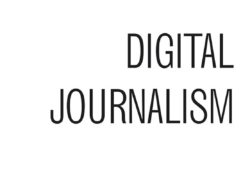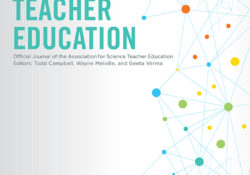eric.ed.gov har udgivet: The Math and Science Partnership (MSP) program at the National Science Foundation (NSF) is a major national research and development effort that supports innovative partnerships among institutions of higher education (IHEs), local K-12 school systems, and their supporting partners in order to improve K-12 student achievement in mathematics and science. Deep engagement of science, technology, engineering, and mathematics (STEM) disciplinary faculty is a hallmark of the MSP program. The program posits that disciplinary faculty hold the content knowledge that K-12 teachers need and that, if faculty are substantially involved, teachers’ disciplinary knowledge will be strengthened, resulting in improved student achievement. Drawing on a larger study that examines the effects of STEM faculty engagement in MSP, this article specifically looks at the tenure and promotion policies in a… Continue Reading →
Like this:
Like Loading...
eric.ed.gov har udgivet: In Larry Clark’s monograph chapter on the education of academically talented college students, he challenged honors educators to consider their role in helping students find their path, particularly through the addition of self-reflection and exploratory projects in honors courses. In an honors first-year experience (FYE) course for science, technology, engineering, and math (STEM) majors at the University of Florida, one assignment was designed in particular to meet the special needs of honors students and to achieve Larry Clark’s goals. This article serves as an illustration and model of “helping students find their path” through Melissa Johnson’s perspective as an instructor, and through the comments of two first-year students–Stephanie Podjed and Sean Taasan–who took an honors FYE course for STEM majors at the University of Florida. The honors… Continue Reading →
Like this:
Like Loading...
eric.ed.gov har udgivet: Children benefit academically when parents and educators work together. For this reason, parents’ involvement in their children’s education is a priority of the “No Child Left Behind Act of 2001.” But a strong connection between parents and educators does not come about automatically. Both parties may need to learn new roles and skills and develop the confidence to use them, especially as parents move beyond traditional activities, like helping children with homework, and toward shared responsibility for school improvement. Intermediary organizations, like federally funded Parental Information and Resource Centers (PIRCs), can help. Drawing on lessons learned from five PIRCs across the country that have been meeting this challenge, this guide shares promising strategies for increasing effective parent involvement. It explains “how to” strategies that the Parent Information… Continue Reading →
Like this:
Like Loading...
tandfonline.com har udgivet en rapport under søgningen “Teacher Education Mathematics”: Abstract Abstract How issues are framed in journalism in terms of problems, solutions, and levels of responsibility is of great importance in order to engage and lead toward individual and collective action. Data journalism has been acknowledged as a practice that often features a high level of interactivity, with the potential to engage the public. In this study, we investigate the content and production of climate change reporting in Swedish public service data journalism and discuss how frames are used in this alternative form of moderated science communication. Our results indicate an unconventional merger between science communication and data journalistic practices where motivational framing is used only to some extent as a way to increase public engagement with climate change.… Continue Reading →
Like this:
Like Loading...
eric.ed.gov har udgivet: California’s shift towards continuous improvement in education makes understanding how districts and schools can learn to improve a more pressing question than ever. The CORE Improvement Community (CIC), a network of California school districts engaged in learning about improvement together, is an important testing ground to learn about what this work entails. This report continues drawing lessons from the CIC’s second year as its districts work together towards a common aim: to improve the mathematics achievement of African American and Latinx students in Grades 4-8. The CIC applies a specific continuous improvement approach, called improvement science, to support teams in reaching the aim. Improvement science, unlike many approaches to reform, is not a specific “program” designed to fix educators’ performance in a particular aspect of their work… Continue Reading →
Like this:
Like Loading...
eric.ed.gov har udgivet: Many factors affect student learning, including school culture to teacher ability to parent support. U.S. schools are trying new ways to improve math and science education by focusing on a variety of these areas. At the core of the efforts are the age-old questions of what to teach and how to teach it–curriculum and instruction. Recent research funded by the National Science Foundation to identify best practices in STEM education shows that students in all types of schools, regardless of size or specialty, can and do engage in high-quality science, mathematics, and engineering. But the extent to which students actually do learn these subjects is a different issue. For effective K-12 STEM instruction to become the norm, schools and districts must be transformed. This brief is presented… Continue Reading →
Like this:
Like Loading...
tandfonline.com har udgivet en rapport under søgningen “Teacher Education Mathematics”: Link til kilde
Like this:
Like Loading...
tandfonline.com har udgivet en rapport under søgningen “Teacher Education Mathematics”: ABSTRACT ABSTRACT In science education, critical discussions on the engagement of industrial actors in STEM education are scarce. In this study, we take the perspective that industrial STEM education initiatives are an arena for governing STEM education. The aim is to contribute to a critical discussion on the involvement of industrial actors in STEM education by scrutinizing how they describe their engagement. More specifically, we look at the discursive repertoires industrial actors put forward as rationales for engaging in STEM education initiatives. The data consist of web materials wherein industrial actors describe and justify their engagements. We identify the following interpretative repertoires used by industrial actors when justifying their engagement in said initiatives: a) Securing competent labour, b) Securing economic… Continue Reading →
Like this:
Like Loading...
eric.ed.gov har udgivet: Science, technology, engineering, and mathematics (STEM) are viewed as fundamental elements in the preparation of our next generation. This is evidenced by President Obama’s goal of “moving our nation from the middle to the top of the pack in math and science education” and his focus on (a) hiring additional STEM teachers; (b) enhancing STEM literacy so students can think critically in key subjects; (c) improving the quality of instruction to help U.S. students perform competitively with those in other nations; and (d) expanding STEM education and career opportunities for women, minorities, and other underrepresented groups (The White House, 2010). To begin laying this foundation for students as they compete in the 21st century economy, educators and decision makers must continue to increase their understanding of various… Continue Reading →
Like this:
Like Loading...
tandfonline.com har udgivet en rapport under søgningen “Teacher Education Mathematics”: Link til kilde
Like this:
Like Loading...



